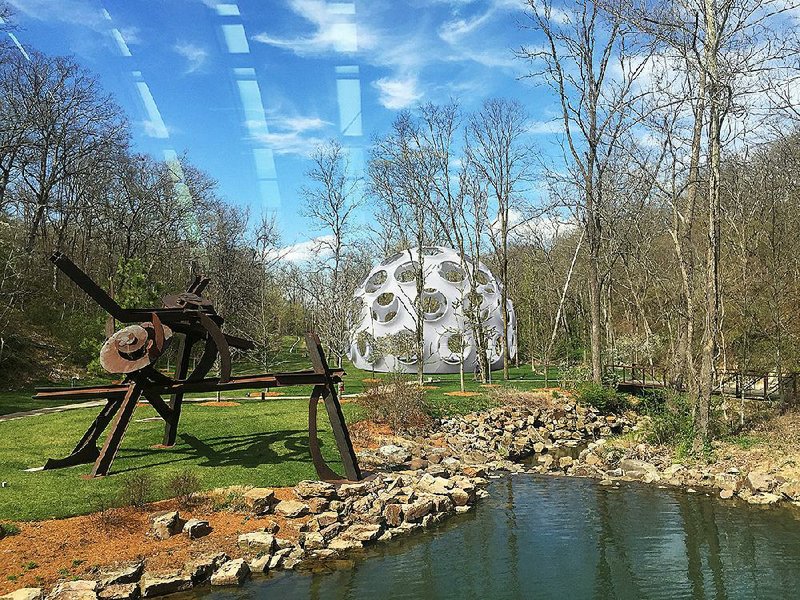Crystal Bridges Museum of American Art has acquired a dome designed by the late architect Buckminster Fuller and will display the structure permanently on its north lawn in 2017.
RELATED ARTICLE
http://www.arkansas…">Children and families try hand at crafts and artwork observation at Crystal Bridges during holiday break
The Fly's Eye Dome, a 50-foot diameter structure made of fiberglass and featuring 61 acrylic windows, was fabricated by Fuller about 1980 as low-cost, portable housing. The dome is roughly the size of a 1,960-square-foot house.
It will be the second home displayed on the Bentonville museum's grounds when it is installed next year, joining Frank Lloyd Wright's Bachman-Wilson house.
"The Frank Lloyd Wright house was monumental in the sense that it gave us another object to talk about architecture and show the principles of one of the greatest American architects at the museum," Crystal Bridges curatorial assistant Dylan Turk said. "Now having [the Fly's Eye Dome] shows that not all architects look at the same problem the same way. Creativity and innovation can happen on so many types of scales and with any type of material and can truly change the world."
Fuller, who died in 1983, was an architect, engineer, author and designer who spent a good portion of his life experimenting with dome structures in an attempt to create low-cost housing globally.
Geodesic domes are regarded as his most well-known "artifacts" and different variations have been produced more than 300,000 times worldwide, according to the Buckminster Fuller Institute's website.
Fuller was specifically inspired to create the Fly's Eye Dome in the 1960s after seeing a picture of a fly. In the mid-1970s he began fabricating the structure -- which looks like a giant Wiffle ball -- with fiberglass expert John Warren.
According to the Buckminster Fuller Institute, the design is "lightweight and can be rapidly assembled or disassembled, while having enough space to provide shelter to a family or even as emergency housing in the case of natural disasters."
The Fly's Eye Dome acquired by Crystal Bridges is one of three prototypes built by Fuller and also is the largest. The other prototypes are 24- and 12-feet in diameter.
"His hopes and dreams would be that you could essentially have a kit -- the molds and the tools to pour your own fiberglass and make the 134 different pieces and build your own dome," said Turk, who added that the domes never went into mass production because challenges in making them complete and inhabitable structures have not been resolved.
The structure acquired by Crystal Bridges was displayed at the Los Angeles Bicentennial celebration in 1981. But it spent the next three decades in storage.
Architectural historian Robert Rubin acquired it in 2001 and restored the dome before it was displayed at the International Art Festival in Toulouse, France, in 2013 and later at the Amsterdam Light Festival.
Crystal Bridges acquired it in early 2015. While the structure has been in the museum's possession for more than a year, Turk said Crystal Bridges held off on announcing the addition while it worked through a "lot of questions."
The dome is currently in pieces in individual crates housed in a museum storage facility.
"It's just been a lot of research and working with engineers and making sure we do it right," Turk said. "We didn't want to announce it and realize it would be another year before anything happened."
Crystal Bridges' announcement came recently in C magazine, which is distributed to museum members. The museum said Fuller's dome seemed "somewhat extreme in its futuristic design and emphasis on 'doing more with less,'" but seems "considerably less far-fetched" today.
The announcement also included comments from Rubin about the value of the structure to architectural scholarship. He said "most major museums ... can't rise to the challenge of architecture because it's not very 'commercial'" and added Crystal Bridges "is in a unique position to fill this void."
In addition to the large structure, which is 36-feet high and weighs 10,000 pounds, Crystal Bridges has acquired the entire Fly's Eye Dome archive that includes letters, models and drawings. Its height is more than three stories tall.
Turk said it is the first time anyone other than Fuller or Warren has gone through the archive, which has allowed Crystal Bridges to learn more about the creative process. Some of the Fly's Eye Dome archives will be on display for the public when the structure opens to visitors in the summer of 2017.
Installation of the dome will take place after construction of a north entrance, which will give museum visitors better access to the spacious north lawn, is completed in the spring.
"It will draw people out there," Turk said about the Fly's Eye Dome. "It celebrates this new entrance and this whole new experience that's going to be happening at the museum."
Metro on 12/30/2016
